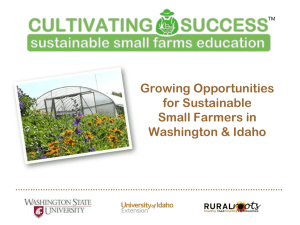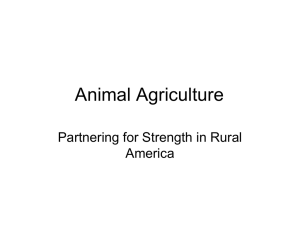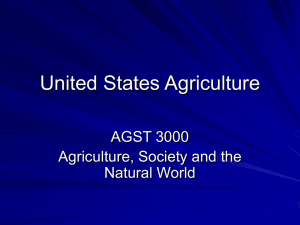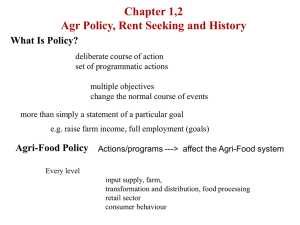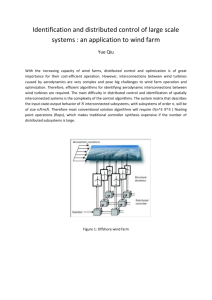farm incomes - Department of Agriculture
advertisement
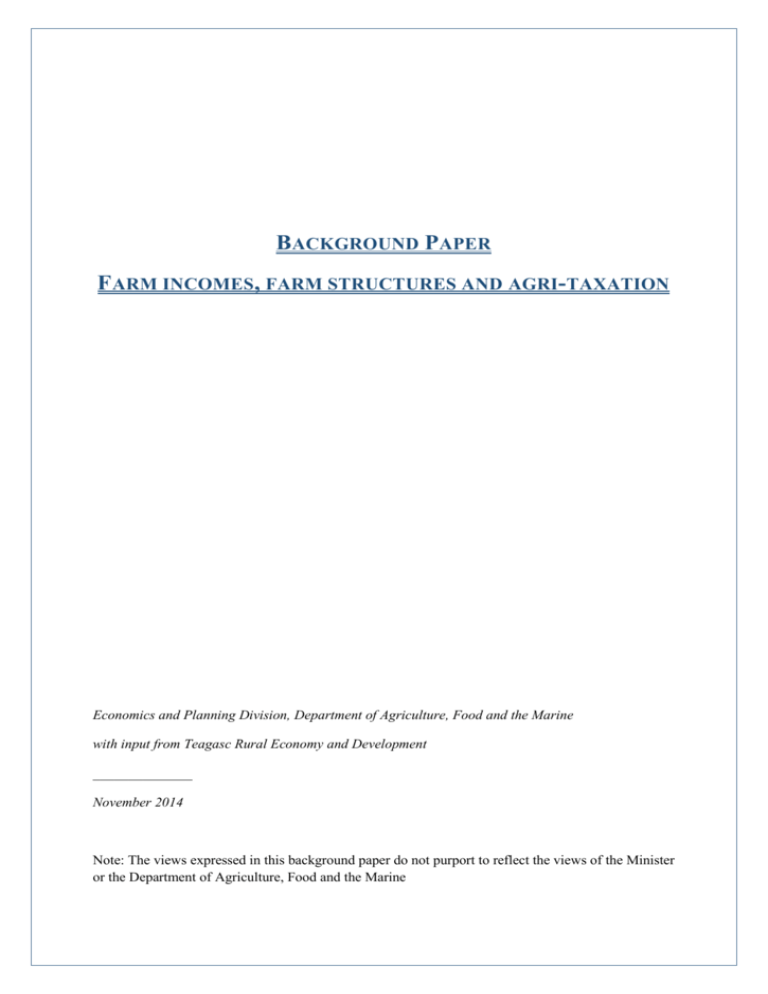
BACKGROUND PAPER FARM INCOMES, FARM STRUCTURES AND AGRI-TAXATION Economics and Planning Division, Department of Agriculture, Food and the Marine with input from Teagasc Rural Economy and Development ______________ November 2014 Note: The views expressed in this background paper do not purport to reflect the views of the Minister or the Department of Agriculture, Food and the Marine FARM INCOMES 1. AGGREGATE FARM INCOME CSO statistics show that aggregate farm income (‘operating surplus’) has been relatively stagnant in nominal terms since 2000, with a very bad year in 2009 followed by a gradual recovery. Direct payments (‘subsidies less taxes’) have generally accounted for around 70% of aggregate income. The dramatic increase in output value since 2009 has not translated into higher aggregate income at farm-gate level, mainly because it has almost been matched by an increase in input costs over the same periodi. Figure 1 Aggregate farm income and subsidies, 2000-2013 Figure 2 Output, inputs and income, 2000 to 2013 1 2. AVERAGE FARM INCOME Teagasc’s annual National Farm Survey (NFS)ii represents the 80,000 farms with a standard output (farm-gate sales) of over €8,000iii a year. Average family farm incomeiv on these farms in 2012 and 2013 was around €26,000, down slightly on 2011. v However, this conceals dramatic differences between farm types. Figure 3 below illustrates the major gap between the relatively good average incomes on dairy farms and the very low average incomes on drystock farms – cattle rearing, cattle finishing (cattle other) and sheep farms - with tillage farms (small in number) in between. The fact that the NFS only represents the 80,000 ‘most commercial’ farms makes this gap even more striking. The drystock sector is characterised by very low profitability and smaller farm holdings. Figure 3 Family farm income by system 2011 to 2013 It should be borne in mind that almost all dairy farms are classified by Teagasc as full-time farms in terms of the labour input requiredvi. Most cattle farms and the majority of sheep farms are classified as part-time in terms of labour input requirements, even though in many 2 cases the farmers do not have an off-farm job, often because they are elderly (see also section 9 below on labour input requirement). Cattle farms are also smaller than dairy farms, with average UAA (Utilisable Agricultural Area) of around 40ha compared to 55ha for dairy farms. Most drystock farms have a negative market return (sales minus direct and overhead costs), and this has been the case for many years. However, their family farm income is positive thanks to a significant level of direct payments. Thus direct payments often account for well over 100% of family farm income on these farms. By contrast, direct payments account for only one-third of income on dairy farms; and 87% of income on tillage farms. Figure 4 Direct payments as % Family Farm Income, NFS 2013 Cattle Cattle Dairying Sheep Tillage Rearing Other All farms Direct payments 21,125 15,811 18,186 18,006 25,909 19,173 Family Farm Income DPs as % FFI 64,371 33% 9,469 167% 15,695 116% 11,160 161% 29,907 87% 25,639 75% Figures 5 and 6 below illustrate that the family farm income on dairy farms is much higher than on tillage or drystock farms, even when farm size is taken into account, by looking at farm income per hectare; and when distinguishing between full-time and part-time farms in terms of labour inputvii. 3 Figure 5 Family farm income per hectare by farm type, 2013 Figure 6 Family farm income by full-time and part-time farm, 2013 3. FARM HOUSEHOLD INCOME Farm income is not the only source of income for farm households. On 29% of NFS farms the farm holder had an off-farm job, and on 51% of farms either the holder and/or spouse had an off-farm job in 2013. Overall, it is estimated that on 75% of farms, either the farmer and/or spouse had another source of off-farm income, be it from employment, pensions or other social welfare payments in 2013. 4 FARM STRUCTURES 4. NUMBER OF FARMS According to the CSO Census of Agriculture 2010, there were 140,000 farms in Ireland, almost unchanged from the number of farms in the 2000 Census. Prior to 2000, there had been a slow but steady decline in farm numbers, particularly in the smaller farm size categories. Figure 7 Farm numbers by farm size category, 1975 to 2010 Farms in Ireland are quite fragmented with the average holding made up of 3.8 separate parcels (Census of Agriculture 2010). This figure has doubled from an average of 1.9 separate parcels per farm recorded in the 1991 Census of Agriculture. The degree of fragmentation is more pronounced in the Border, Midlands, West (BMW) region with an average of 4.3 parcels per holding, compared with 3.5 in the South & East region in 2010. 5. NATIONAL FARM SURVEY VIABILITY ANALYSIS Teagasc’s National Farm Survey is representative of 80,000 farms, with a standard output greater than €8,000 a year. Recent Teagasc analysis suggests that just over one-third of these farms are ‘viable’, one third are ‘sustainable’ and one third are ‘vulnerable’viii. 5 35% (28,000) farms are viable: A farm is defined as economically viable if it can remunerate family labour at the average agricultural wage, and provide a 5% return on non-land assets. Most viable farms are in dairying or tillage farming systems, with 79% of dairy farms and 56% of tillage farms recorded as economically viable in 2013. 33% (26,000) are ‘sustainable’: These farms are not economically ‘viable’ on the basis of their income from farming, but they are classified as sustainable due to offfarm employment of the farm holder and/or spouse. 32% (25,000) are ‘vulnerable’: The income from farming is not sufficient to make these farms economically viable, and they have no off-farm employment. About half of these farm holders are aged over 65. These farmers could be seen as being in a period of transition from active farming towards retirement and farm transfer; whether through sale, long-term leasing or transfer to a family member. However, the number of such farms has not shown any significant change over the last decade. 6. FARMS OUTSIDE NFS Less information is available about farms outside the National Farm Survey definitions, but some analysis has been carried out based on Department of Agriculture, Food and the Marine (DAFM) databases: There are around 2,000 commercial pig, poultry, horticulture and potato farms, which are not covered by the National Farm Survey. These farms have a very commercial focus and can be assumed to be viable. Around 50,000 farms are ‘small’ in economic terms: their standard output is less than €8,000 a year. Some data is available on these farms as they are in receipt of DAFM direct payments, but no information is available on their input costs or farm income. Their average farm size is 19 hectares, and over 80% of these farms are drystock farms, mainly cattle. They have a low average stocking density of 0.52 livestock units per hectare. Although small in scale individually, and contributing very little to total agricultural output, such farms account for almost 850,000 hectares of agricultural land, and 436,000 livestock units. (Details in Appendix Table C). Little information is available on a further 8,000 ‘micro’ farms, not in receipts of direct payments. It is assumed that most of these are very small-scale or ‘hobby’ farms. 6 Figure 8 Farm numbers by viability category a) b) c) d) e) f) g) National Farm Survey: represents farms with a standard output of >€8,000 a year, excluding pig and poultry farms. Standard Output (SO) is the average monetary value of the agricultural output at farm-gate price. The SO excludes direct payments, VAT and taxes on products. Viable: family farm income can remunerate family labour at the average agricultural wage, and provide a 5% return on non-land assets Sustainable: not economically ‘viable’ on the basis of their farm income from farming, but sustainable due to offfarm employment Vulnerable: not economically viable and with no off-farm income Small: standard output is less than €8,000 a year; not covered by NFS but some data available from DAFM databases. Pigs/poultry/horticulture/potatoes: commercial farms, but not covered by NFS. Micro: little data available The following charts show the breakdown of these categories by farm system. 7 Figure 9 ‘Viable’ farms by farm type Figure 10 ‘Sustainable’ farms 8 Figure 11 ‘Vulnerable farms’ Figure 12 ‘Small’ farms by farm type 9 7. AGE STRUCTURE An ageing farm population is a problem for many EU countries, including Ireland. According to Eurostat/CSO figures, only 7% of Irish farmers were aged under 35 in 2010, around the EU average; while 25% of Irish farmers were aged 65 or over in 2010, slightly better than the EU average of 30%. One of the priorities for the new round of the Common Agricultural Policy (CAP) reform is to provide new and enhanced support for young farmers in both Pillars of the CAP. The age profile of farmers was analysed using data from DAFM’s Corporate Customer System (CCS) for 2012ix. 123,500 farmers were captured in this analysis and results show that the average age of a farmer is 56. The proportion of farmers under 35 is 5.5% (6,800) of total farmers – lower than the number of farmers over 80 (7,200 or 5.8% of the total). Almost 29% of farmers (35,500) were over 65. Figure 13 Age structure 2012 (DAFM client database) 10 8. GENDER Data from DAFM’s client databases shows that in 2012, only 13% (15,500) of the 123,500 farmers in receipt of Single Farm Payments (SFP) were women. Women were slightly older than their male counterparts with an average age of 61 compared to 56 for men. However, 41% of women with a farm in their sole name were aged over 65. This might indicate that most of these women only received the farm when they were widowed. Women owned 10% of the eligible land declared for SFP, and received only 8% (€101m) of total SFP payments. 9. LABOUR INPUT REQUIREMENT NFS data can be used to examine the extent to which there is excess labour supply on farms. On average, labour input on Irish farms is estimated to exceed labour requirements by 52%. Under-employment is particularly evident on cattle and sheep farms, whilst dairy farms could be described as over-employed as they have less labour available than required. More details on labour input requirement on Irish farms are outlined in Appendix Table D. 10. BORROWINGS AND INVESTMENT Gross new investment in farming totalled €726 million in 2013, an increase of almost 12% on the 2012 level. Average gross new investment per farm was a little over €9,000. Within the sectors the average gross new investment ranged from over €20,500 per dairy farm to €3,790 per sheep farm in 2013. The average borrowings per farm in 2013 was estimated at €24,400. A large majority of farms have no farm business related debt, although this varies considerably across farm systems. The average borrowings on Dairy farms were €65,737 compared to a little over €8,000 on Cattle Rearing. Figure 14 Borrowings and Investment 2013 Cattle Cattle All Dairy Sheep Rearing Other Farms Gross New Investment € 20,531 4,745 5,579 3,790 9,175 Loans Closing Balance € 65,737 8,213 13,193 10,304 24,398 Source: Teagasc National Farm Survey 2013 (Note – represents the 80,000 largest farms) 11 Tillage 14,471 30,268 11. LAND MOBILITY The low level of land mobility in Ireland is one of the main structural challenges facing the agriculture sector. There is a dearth of official data on sales, leasing and rental activity in the Irish land market to ascertain the current extent of land mobility. Notwithstanding these data gaps, recent trends in this area are examined here using various official, administrative and other sources. Sales Data The 2013 agricultural land price report in the Farmers Journal x produces a comprehensive analysis on land sales in Ireland. It reported that 1,484 land parcels amounting to 30,300 hectares were offered for sale in 2013, but less than half of these parcels (670 or 12,400 hectares.) were actually sold. Despite an increase in the volume of land for sale over previous years, this still only constitutes less than 1% of the total land area in the country with less than 0.5% of the total land area actually achieving a successful sale. The average price paid for land in 2013 was €23,200/ha. Leasing and Rental Data DAFM analysis of the SFP database in 2012 found that the average area leased was 18.8 ha per farm, based on almost 54,000 farms renting just over 1 million hectares in 2012. The comparable figure from the 2010 Census of Agriculture was 41,500 farms renting 784,000 ha or an average of 18.9 ha per farm. Neither of these sources allows for a reliable disaggregation of the prevalence of short term rentals versus longer term leases. However it seems likely that the majority of rental/leases are made up of short term or conacre arrangements given that the numbers availing of the income tax exemption for leasing of farm lands (available for leases for >5 years) was circa 3,600 for both the years 2011 and 2012. Teagasc/SCSI’s Land Market Review and Outlook 2014 noted that, in general, the trend in land rental prices has been upwards since 2010. Significant increases in rental prices have been recorded for grazing-only land in the past four years reflecting the strong demand amongst dairy farmers to expand and increase productivity. Market rents for tillage land are typically higher than land for grazing/silage. 12 12. COLLABORATIVE FARMING Collaborative farming refers to newer models of farming and can a play a role in resolving both the land mobility challenge and lowering the overall average age of those in involved in Irish agriculture. There are a number of different types of arrangements that fall within the heading of collaborative farming, such as contract rearing and share farming. Currently the most prevalent collaborative farming model practiced in Ireland are the Milk Production Partnerships, which are the only form of formal farm partnership provided for within the suite of agriculture legislation. These were introduced in 2002 and there are currently around 700 registered partnerships. DAFM is finalising detailed rules to provide for a formal registration mechanism for all types of farm partnerships. It is planned that the formal register will help ensure non-milk producers in farm partnerships are not disadvantaged from DAFM scheme participation and can avail of other State benefits, such as the 50% stock relief from income tax measure, which is currently restricted to MPPs and thus help widen the uptake of this farming model. Increasing resources are being deployed in developing and promoting a number of types of collaborative farming models, through mechanisms such as DAFM’s grant aid schemes, Teagasc Advisory Services and a pilot Land Mobility Programme Initiative – a recently established land brokerage service with industry wide support. 13. OFF FARM EMPLOYMENT/FARM DIVERSIFICATION NFS data for 2013 shows that on 29% of farms, the farm holder had an off-farm job, while on 36% of farms, the spouse had an off-farm job. In 51% of farm households either the holder and/or spouse had an off-farm job. On drystock farms the holder is more likely to have an off-farm job, while on dairy farms, the spouse is much more likely to have an off-farm job. 13 Figure 15 Off-farm employment, NFS 2013 Traditionally, farm diversification has been seen as introducing a new enterprise on farms, such as agri-tourism, or the introduction of alternative farm enterprises. Advisory service now take a more holistic approach to farm diversification, analysing the skills of the farm family and the resources available, and coming up with a workable plan to improve farm household income. This might involve off-farm employment, starting up alternative on-farm enterprises, or innovative approaches to maximising existing farm enterprises through innovative approaches such as collaborative farming. Teagasc’s Options programme and other advisory services are supporting farm families in exploring new ways to improve household income. 14 AGRI TAXATION AND THE AGRI-TAXATION REVIEW Background The Agri-taxation Review is a comprehensive examination of agri-taxation measures, which are a critical element of Government support to the primary agriculture sector. The Review, a joint initiative by the Departments of Finance and Agriculture, Food and the Marine, was published as part of Budget 2015. Taxation policy for the sector and the resultant taxation measures have grown incrementally over many years and the Review presented a unique opportunity to examine this policy in the context of the strategy of expansion and increasing exports under Food Harvest 2020. The Review provides a strong evidence base for continued assistance to the primary sector through taxation measures and sets out a clear strategy with three new specific policy objectives for the future. Policy objective 1: Increase the mobility and the productive use of land The first main policy objective of agri-taxation is to increase land mobility and the productive use of land. Access to land and the low level of land mobility is one of the main challenges facing farmers who want to increase their productivity. There is a growing consensus that access to land, and its productive use, is becoming more of an issue than ownership. While there is an active rental market, the majority of these cases are for short-term conacre lettings. Long-term leasing has a number of advantages over the conacre system, it allows progressive farmers to enlarge their farm holdings and increase productivity and also: Allows young farmers and new entrants to the sector gain access to land by providing a cheaper means of long-term access to land, as opposed to the relatively high cost of land purchase. Provides security of tenure and the certainty required to encourage lessees to maintain and make investments in improving land. Is especially important in accessing bank credit (financial institutions generally match loan terms to lease duration and longer duration allows for phased repayment on capital investment). Provides a route to retirement for older farmers, assisting in generation renewal. 15 The existing relief for income from leasing of farm land is retained and five new measures to assist in rebalancing the market in favour of longer-term leases were introduced in Budget 2015: An increase of 50% in the thresholds of relief for long-term leasing income. The introduction of a fourth threshold for lease periods of 15 or more years. The removal of the lower age threshold of 40 years for long-term leasing relief eligibility. The inclusion of non-connected limited companies as an eligible lessee for long-term leasing relief. The relief of stamp duty on long-term leases (5 years or more). Some key facts on land mobility and access to land: Less than 0.5% of the total land area is currently sold per annum. Nearly 54,000 farmers (or 41% of farms) rent or lease land from other land owners. The vast majority of these cases are for short-term conacre (11 month) lettings. Policy objective 2: Assist succession The second main policy objective of agri-taxation is to assist succession. The age profile of Irish farmers is increasing and it is recognised that there are many social and economic reasons why succession management is a challenge for farmers. Assisting succession and the transfer of farms has been a central part of the Government’s agri-taxation policy and Budget 2015 included a number of measures to maintain and strengthen that support, specifically the retention of Agricultural Relief from Capital Acquisitions Tax, Retirement Relief from Capital Gains Tax and the current stamp duty exemptions on transfers of land. Four new measures were introduced in Budget 2015: A targeting of Agricultural Relief from Capital Acquisitions Tax to qualified or full-time farmers or to those who lease land out on a long-term basis. Non-farmers who may have qualified for Agriculture Relief under the less restrictive criteria will not now qualify. For transfers under Retirement Relief, the extension of the eligible letting period of a qualifying asset to 25 years. This is mainly for family situations where successors are too young to take over a farming business. For transfers other than to a child under Retirement Relief, as a once-off measure until the end of 2016, the inclusion of conacre lettings as eligible. There is a cohort of farmers who 16 are effectively caught in conacre arrangements without exit options. During the period to the end of 2016, they can either decide to transfer their land and qualify for Retirement Relief or enter into a long-term lease and qualify for Retirement Relief in the future. The extension of Stamp Duty Consanguinity Relief, i.e. relief to related persons, on nonresidential transfers to the end of 2017, with restrictions of the relief to active farmers. Some key facts on succession: The number of farmers aged under 35 fell by more than 50% between 2000 and 2010 to just 6.2% of all holders. More than half (51.4%) of all farm holders in 2010 are aged 55 years or older, while more than a quarter (26.3%) of all farm holders are aged over 65 years. An estimated 50% of farmers aged over 50 years do not have an identified farming successor. Policy objective 3: Complement wider agriculture policies and schemes The third policy objective of agri-taxation is to complement wider agriculture policies and schemes. Taxation measures have a specific role to play in areas that are primarily supported through other policies such as the CAP. Three new measures were introduced in Budget 2015: To encourage greater farm efficiency and environmental sustainability, the farm restructuring measure (i.e. relief from Capital Gains Tax on eligible transactions) is extended to the end of 2016 and now includes whole-farm replacement as eligible. In response to increasing income volatility, the Income Averaging measure is being enhancing by increasing the averaging period from 3 to 5 years, and also, Allowing averaging to be availed of where a farmer and/or their spouse receive income from an on-farm diversification trade or profession. As well as these 12 new measures, important existing agri-taxation measures are retained: To support investment to enhance competiveness, including assisting new entrants and young trained farmers, the current Capital Allowances and current Stock Reliefs available to the sector are retained. To assist environmental sustainability, profits or gains from the commercial occupation of woodlands remain tax exempt. 17 To support alternative farming models such as farm partnerships, current measures are retained. Some key facts on agri-taxation measures Capital Allowances rank first in terms of direct exchequer cost among the agri-taxation measures, with an estimated costing of some €192 million in 2011. Agricultural Relief from Capital Acquisitions Tax is second in terms of direct exchequer cost with an estimated costing of some €77 million in 2012. The estimated direct annual exchequer costs of agri-taxation measures amounted to nearly €340 million. The findings of the independent cost-benefit analysis and associated econometric analysis were positive in terms of continuing supports for the primary sector through taxation measures. Outlook It is envisaged that the package of measures introduced in Budget 2015, the most substantial package of this kind ever introduced in a single budget, will lead to a more efficient and productive sector in anticipation of the significant challenges and opportunities ahead. The Agri-taxation Review has produced a comprehensive taxation strategy for the sector and will form the basis of agri-taxation policy for a number of years to come. The 12 new measures are part of an overall package recommended by the Agri-taxation Working Group, which will examine additional issues identified by the Review and continue to monitor the effectiveness of agri-taxation measures. 18 CONCLUSIONS There is a significant gap in terms of farm incomes and viability between dairy farms on the one hand, and cattle and sheep farms on the other, with tillage farms in between. The number of dairy farms has reduced over time, and their scale and efficiency has increased. As a result, most dairy farms are viable farm enterprises with reasonable incomes. By contrast, most cattle and sheep farms are small scale, with relatively high input costs, low profits and a huge dependence on direct payments as a source of income. Some drystock farms are sustainable due to off-farm employment of the farm holder and/or their spouse. Small-scale cattle farms are well suited to part-time farming in terms of the labour input required. Teagasc’s Options programme is actively encouraging and supporting farm families to examine new sources of income, both on-farm through diversification and innovative approaches such as contract rearing, partnerships and share farming; and through off-farm employment opportunities. However, there remains a cohort of drystock farmers, mainly elderly, who are operating inefficient farms on a small scale. These farmers are not using their assets productively, particularly scarce agricultural land which could be used more effectively by younger trained farmers. The recent Agri-taxation Review is a comprehensive examination of agri-taxation measures, which are a critical element of Government support to the primary agriculture sector, and provides a strong evidence base for continued assistance to the sector through the taxation system. It is a taxation strategy for the sector and will form the basis of agri-taxation policy for a number of years to come, with three new specific policy objectives outlined: o Increase the mobility and the productive use of land o Assist succession. o Complement wider agriculture policies and schemes (i.e. supporting investment to enhance competiveness, environmental sustainability, alternative farming models and responses to increasing income volatility. 19 Appendix Table A Goods output Inputs (Intermediate Consumption) - Fixed capital consumption + Subsidies less taxes + Contract work compensation of employees Operating surplus O UTPUT , INPUTS AND INCOME IN AGRICULTURE 2000-2013 2000 2001 2002 2003 2004 2005 2006 2007 2008 2009 2010 2011 2012 2013 4,884 5,102 4,711 4,839 5,023 5,041 5,228 5,728 5,880 4,755 5,365 6,301 6,701 7,256 3,208 3,469 3,413 3,465 3,516 3,745 4,015 4,226 4,700 4,191 4,261 4,828 5,292 5,708 590 618 636 640 652 648 668 704 769 780 734 710 717 725 1,200 1,255 1,493 1,470 1,465 2,080 1,794 1,805 1,863 1,804 1,639 1,801 1,630 1,505 -124 -92 -130 -143 -143 -139 -154 -160 -155 -159 -157 -118 -101 -74 2,163 2,177 2,025 2,061 2,177 2,590 2,186 2,442 2,118 1,429 1,853 2,447 2,221 2,254 Source: CSO OII Statbank; only key variables shown 20 Table B N ATIONAL F ARM S URVEY RESULTS 2013 Cattle Rearing Cattle Other Sheep Tillage 15,583 20% 16,691 21% 24,601 31% 12,656 16% 6,645 8% 79,103 100% "Full time farms"* 14,792 "Part time farms" 791 * Full time defined as requiring at least 0.75 of a standard Labour Unit 2,136 14,555 5,616 18,985 4,588 7,989 2,927 3,639 32,274 46,433 NATIONAL FARM SURVEY 2013 Dairying Total farms represented % of all farms All Sizes % full time by system % part time by system 95% 5% 13% 87% 23% 77% 36% 63% 44% 55% 41% 59% Family farm income Full time farms Part time farms All farms 65,287 19,869 62,994 20,019 7,988 9,541 30,999 11,141 15,667 19,506 7,252 11,731 46,073 15,056 28,797 47,646 9,953 25,437 33% 48% 34% 150% 170% 165% 104% 132% 119% 141% 185% 158% 90% 95% 92% 57% 140% 77% 57 24 55 66 34 38 69 32 40 65 47 53 101 32 63 66 35 48 1,143 814 1,137 306 235 250 449 351 389 301 156 220 456 469 460 724 285 534 382 391 383 460 399 412 466 464 464 425 287 348 412 446 422 416 400 409 -154 -164 -162 -17 -112 -75 -124 -132 -128 44 23 38 308 -115 125 25 45 43 19 37 33 17 35 29 12 54 35 12 40 29 Direct payments as % FFI Full time farms Part time farms All farms Utilisable Agricultural Area (UAA) ha Full time farms Part time farms All farms Family farm income per ha Full time farms Part time farms All farms Direct payments per ha Full time farms Part time farms All farms Market return per ha (UAA)** Full time farms 761 Part time farms 423 All farms 755 ** Gross output, excluding direct payments, minus direct and overhead costs % of farm holders with off farm job Full time farms Part time farms All farms 7 30 8 Note: Results for mixed livestock farms (representing 2,600 farms) excluded 21 Table C Farm size and type LARGE Cattle other Cattle rearing Dairying Mixed Livestock Sheep Tillage MEDIUM Cattle other Cattle rearing Dairying Mixed Livestock Sheep Tillage SMALL Cattle other Cattle rearing Dairying Mixed Livestock Sheep Tillage Grand Total Cattle other Cattle rearing Dairying Mixed Livestock Sheep Tillage CAP A NALYSIS DATABASE 2010 BY SIZE ( STANDARD OUTPUT ) Number of farms Livestock Units Avg stocking Avg farm density Total Area (LU/ha excluding size ha arable area) (ha) (ha) 19,971 2,448,921 1,497,685 1.94 75 1,135 851 13,769 1,282 762 2,172 218,661 161,788 1,689,012 157,961 113,447 108,052 129,116 83,921 824,737 96,759 117,074 246,078 1.81 1.99 2.12 1.94 0.99 1.51 114 99 60 75 154 113 54,487 2,370,348 2,245,849 1.11 41 15,601 21,524 1,990 976 10,219 4,177 766,203 1,036,078 70,196 47,254 383,492 67,126 654,912 769,748 50,688 34,786 573,101 162,615 1.19 1.35 1.39 1.38 0.67 0.90 42 36 25 36 56 39 48,553 436,439 848,739 0.52 17 18,901 14,453 14 154 6,927 8,104 186,394 175,573 101 1,162 56,122 17,087 339,829 216,930 172 5,470 145,786 140,553 0.55 0.81 0.59 0.21 0.39 0.13 18 15 12 36 21 17 123,011 5,255,709 4,592,273 1.24 37 35,637 36,828 15,773 2,412 17,908 14,453 1,171,258 1,373,439 1,759,309 206,377 553,061 192,265 1,123,857 1,070,598 875,597 137,015 835,960 549,245 1.06 1.29 2.08 1.70 0.67 0.69 32 29 56 57 47 38 Small: standard output <€8,000 Medium: standard output between €8,000 and €48,000 Large: standard output >€48,000 Standard output (SO) is the average monetary value of the agricultural output at farm-gate price. The SO excludes direct payments, VAT and taxes on products. Notes: This analysis is based on DAFM SPS recipients database, 2010 ‘Large’ and ‘medium’ categories (total 75,000) together correspond roughly with the 80,000 farms represented by the National Farm Survey. ‘Small’ represents almost 50,000 farms with standard output below €8,000, so not represented by the NFS. Farms excluded from this database would include specialist pig and poultry farmers, and farms not in receipt of single payments, presumably many of which are micro/hobby farms. 22 Table D L ABOUR I NPUT REQUIREMENT , NFS 2012 Comparison of Actual Labour* versus Estimated Labour Requirement (Standard Man Days**), 2012 Dairy Cattle Rearing Cattle Other Sheep Tillage All Systems Total actual labour units 1.61 1.39 1.48 1.37 1.61 1.47 SMD labour units 2.14 75% 1.08 128% 1.42 104% 1.24 111% 1.80 89% 1.70 86% 1.15 0.98 1.01 1.01 0.79 0.92 0.62 187% 0.38 256% 0.39 258% 0.45 226% 0.41 191% 0.38 244% Total actual labour units 1.59 1.03 1.11 1.14 1.14 1.21 SMD labour units 2.06 0.47 0.62 0.73 1.01 0.80 Total actual labour as % SMD 77% 220% 180% 157% 113% 152% Full-time farms Total actual labour as % SMD Part-time farms Total actual labour units SMD labour units Total actual labour as % SMD All farms Source: Kinsella, A. Moran, B, (2014) Analysis using National Farm Survey 2012 data. *Actual labour unit is defined as 1,800 hours or more worked on a farm by a person over 18 years. **Standard Man Days (SMD) Labour Unit eight hours of work supplied by a person over 18 years of age. The number of SMD required per hectare for the different crops and per head for various categories of livestock is used to calculate the total number of SMDs required to operate the farm 23 SOURCES DAFM: Annual Review and Outlook for Agriculture, Food and the Marine 2013/14 and 2012/13 DAFM: Food Harvest and Milestones reports Teagasc: National Farm Survey, various years Teagasc: Rural Development conference, September 2014, event proceedings DAFM/Teagasc: CAP analysis database 2010 Agri-tax review: http://www.agriculture.gov.ie/agri-foodindustry/agri-taxationreview/ ENDNOTES i Source: CSO Output, Input and Income; CSO Statbank; more detail in Appendix Table A. http://www.teagasc.ie/nfs/reports.asp iii Standard output (SO) is the average monetary value of the agricultural output at farm-gate price. The SO excludes direct payments, VAT and taxes on products. iv Family Farm Income per Farm (FFI) is calculated by deducting all farm costs (direct and overhead) from the value of farm gross output. Factors of production owned by the farmer, such as labour and land, are not included as costs. FFI therefore represents the financial reward to all members of the family, who work on the farm, for their labour, management and investment. It does not include income from non-farming sources and thus may not be equated to household income. v NFS methodology changed in 2011 to exclude any farm with standard output < €8,000; previous surveys excluded only farms with standard output <€4,000; so results before the 2011 survey are not directly comparable. vi In the NFS full-time and part-time farms are based on labour input, with farms requiring 0.75 of a standard labour input being defined as full-time and those requiring less as part-time. vii More detail on NFS results is presented in Appendix Table B viii F. Thorne, http://www.teagasc.ie/publications/2014/3305/Farm_Viability_Analysis.pdf ix Both a herd number and a date of birth, based on the individual’s PPSN, are recorded on the CCS. However any young farmers operating in a partnership with a parent or who are in a husband/wife partnership are excluded from this analysis. x Irish Farmers Journal, Agricultural Land Price Report 2013 ii 24



